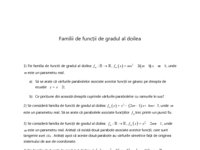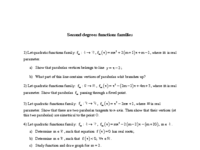
Lesson plan - Quadratic functions families
General information
[list][*]Subject: [i]Mathematics[/i][br][/*][*]Class: [i]9th grade[/i][br][/*][*]Duration: [i]50 min.[/i][br][/*][*]ICT tools: [i]computer teacher projector, computers for students, or tablets, Internet connection.[/i][i] [/i][i][/i][/*][/list]
Lesson's topics
[i][i]Second degree [/i]functions families[br][/i]Consolidation lesson and solving problems.
Specific objectives
[i]At the end of the lesson, students will be able to:[br][/i][list][*][i]study and discuss the properties of quadratic functions with parameter ( [/i][i]the behavior of the function, nature and sign of roots, trajectory of vertex), depending on the real parameter given;[/i][/*][*][i]determine the value of a parameter, so that the function to have certain properties.[/i][/*][/list]
Operational objectives and evaluation
[i]During the lesson, students will become able to:[br][/i][list][*][i]identify, characterize or define families of functions that depend on a real parameter;[/i][/*][*][i]study and describe the properties of quadratic functions with parameter determining discriminant, roots, extreme point;[/i][/*][*][i]discuss the behavior of the function, nature [i]and sign of roots, trajectory of vertex[/i], depending on the real parameter given.[/i][/*][/list]
Teaching strategies
[i]Type of lesson:[/i] [br]Lesson "Family Function second degree" is a deepening of knowledge and is addressed for students from mathematics or computer science. [br][br][i]Preliminary knowledge:[/i] [br]Students have already learned to study the function of the second degree by signs of dominant factor and discriminant, and can solve second degree equations and inequalities, and reducible to, even with parameter. The novelty of the lesson consists the increased difficulty of the problems, all problems involve the existence of a parameter to be discussed.[br][br][i]Strategies and methods:[/i][br]The chosen strategy is to combine solving problems using new technologies in order to help increase understanding and retention. Where appropriate, we will use GeoGebra both to verify the results and to view studied objects, but also as a source of inspiration to stimulate intuition, helping students in their attempt to demonstrate the properties required by anticipating the results and identify certain repetitive patterns. [br][br][i]The integration of new technologies:[/i][br]To each proposed problem, students will be free to use as they wish GeoGebra Graph Calculator (including CAS). However, to streamline activities, we recommend an application ready before that displays Algebra sheet and Graphics sheet with a parameter already introduced as a slider m. Students must enter the given function in the input bar, to observe points special, to draw path (Trace on) of the parabola vertex and to start cursor animations. All these actions are facilitated by GeoGebra Graph Calculator by displaying a keyboard easy to use, but also automatically display special points (roots and the vertex of the parabola). It also assumes that students already have used GeoGebra before, although a possible training would take several minutes.[br][br][i]Activity itself:[/i] [br]We propose to students a set of 10 problems to be solved, at least 4-5 for this lesson and next will remain as homework. For each issue, students use interactive sheet.[br][br][br][i]1) Let the family of second-degree functions: [/i][math]f_m:\mathbb{R}\longrightarrow\mathbb{R},f_m\left(x\right)=mx^2+2\left(m+1\right)x+m-1[/math][i], where [/i][math]m[/math][i] is a real parameter. [br] a) Show that these parabolas vertices are on the line [/i][math]y=x-2[/math][i]. [br] b) What portion of this line includes parabolas with branches up?[br][br][/i]Comment: Visualizing family of functions, students can predict the outcome, and thus facilitate the demonstration. [i][br][br]2) [i]Let the family of second-degree functions[/i][i]: [math]f_m\left(x\right)=x^2-\left(2m-1\right)x+4m+3[/math], where [math]m[/math] is a real parameter. [/i][/i] [i]Show that the parabolas associated to functions [math]f_m[/math] passing through a fixed point. [br][br]3) [i][i]Let the family of second-degree functions[/i][i]: [math]f_m\left(x\right)=x^2-2mx+1[/math], where [math]m[/math] is a real parameter. [/i][/i]Show that there are two parabolas that are tangent to x-axis. Show that vertices of these two parabolas are symmetrical to the origin of the coordinate axes. [br][br]4)[i][i]Let the family of second-degree functions[/i][i]: [math]f_m\left(x\right)=mx^2-2\left(m-2\right)x-\left(m+10\right)[/math], where [math]m[/math] is a real parameter.[br] [/i][/i]a) Determine [math]m\in\mathbb{R}[/math] that the equation [math]f\left(x\right)=0[/math] has real roots. [br] b) [i]Determine [math]m\in\mathbb{R}[/math], such that [math]f\left(x\right)<0,\forall x\in\mathbb{R}[/math][/i]. [br] c) Study and plot the parabola for [math]m=2[/math]. [br][br]5) [i]Let the family of second-degree functions[/i][i][i]: [math]f_m\left(x\right)=\left(m-2\right)x^2+\left(m+1\right)x+4[/math], where [math]m[/math] is a real parameter.[br][/i][/i] a) Find the values of [math]m\in\mathbb{R}[/math] that equation [math]f\left(x\right)=0[/math] has real roots. [br] b) Find [i][i][math]m\in\mathbb{R}[/math][/i][/i] that [math]f\left(x\right)>0,\forall x\in\mathbb{R}[/math]. [br] c) Study and plot for [math]m=1[/math].[br][br][/i]6) [i][i]Let [i]the family of second degree functions: [math]f_m\left(x\right)=mx^2+\left(1-3m\right)x+2m-1[/math], where [math]m[/math] is a real parameter. Show that these functions parabolas pass through two fixed points.[br][br][/i][/i][/i]7)[i][i] Let [i]the family of second degree functions: [/i][/i][/i][i][i][i][math]f\left(x\right)=mx^2+2\left(m+n\right)x+m+2n[/math], where [/i][/i][/i][i][i][i][math]m\in\mathbb{R}^{\ast},n\in\mathbb{R}[/math][/i][/i][/i][i][i][i].[/i][/i][/i][br][i] a) Prove that for fixed [/i][math]n[/math],[i] vertices of parabolas are on the right. [br] b) Let A, B points of intersection of x-axis and F projection of vertex V to x-axis. Show that [/i][math]\forall m\in\mathbb{R}^{\ast}[/math][i], [/i][math]2\cdot VF=\mid n\mid\cdot AB[/math][i]. [br] c) Show that all parabolas passing through a fixed point. [/i] [br][br][i]8) Let the family of second degree functions: [/i][math]f_m\left(x\right)=mx^2+2\left(m+1\right)x+m+2[/math][i], [i][i][i] where [math]m[/math] is a real parameter.[br][/i][/i][/i] a) Show that these parabolas vertices are on the line [/i][math]y=x+1[/math][i]. [br] b) Prove that all previously defined parabolas pass through a fixed point. [br][br]9)[/i] [i]Let the family of second degree functions[/i]: [math]f_m\left(x\right)=mx^2+2\left(m-1\right)x+m-1[/math], where [math]m\in\mathbb{R}^{\ast}[/math].[br] a) Prove that these parabolas vertices are on the line [math]x+y=0[/math] [br] b) Prove that these parabolas pass through a fixed point.[br][br][i]10) Let the[i] family functions [math]f_m\left(x\right)=\left(m+1\right)x^2-2\left(m+2\right)x+m+2,m\ne-1[/math][br][/i][i] a) Show that the parables [math]f_m[/math] passing through a fixed point .[/i][br][i] b) Show that the vertices of these parables are on the line [math]x+y=0[/math]. [br] [/i][i][i][i]c) Determine the portion of the line from b) that contains vertices of branches up parabolas.[/i][br][/i] d) Determine the parameter [i][i][i][math]m[/math] [/i][/i][/i]so that vertices of parabolas are: [/i][/i][br][i] 1. above the x-axis.[/i][br][i] 2. on the x-axis.[/i][i][i][i][i][i][i][i][i][br] 3. to the right of y-axis.[/i][/i][/i][/i][/i][/i][/i][/i][br][i] 4. on the line[i][i] [i][i][i][math]y=1[/math].[/i][/i][/i][/i][/i][/i][br][i] 5. under the line[i][i] [i][i][i][math]y=-2[/math][/i][/i][/i][/i][/i][/i][i].[br][br][/i]see [i][url=https://www.geogebra.org/m/rhNtGgFw]https://www.geogebra.org/m/rhNtGgFw[/url][/i][br][br]Comments: [br][list][*]At problems 1 to 3, 6 and 9, students can anticipate some details of the solution and thus facilitate the demonstration, slider m and setting of animation from trace on the objects;[br][/*][*]At problems 4,5,7 and 10, the viewing functions can confirm / disprove the solutions.[/*][/list]
Resources
[i]Interactive sheet: [url=https://ggbm.at/gH8QAZNd]https://ggbm.at/gH8QAZNd[/url] [br]Problem 9: [url=https://www.geogebra.org/m/TdX9TrGZ#material/YuptsMx2]https://www.geogebra.org/m/TdX9TrGZ#material/YuptsMx2[/url] [br]Printed sheet: [url=https://ggbm.at/etrkd867]https://ggbm.at/etrkd867[/url][br][/i]
Integrating new technologies
[i]Computers can be replaced with smartphones if there is Internet connection. Where new technologies can't be applied, use only printable sheet.[/i]

